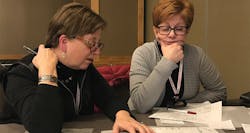The Power of Charrettes
The word “charrette” is derived from the French term for “little cart.” Today, a charrette is an intensive planning session in which all constituents of a project—citizens, designers, and other collaborators—can participate in a vision for development, drafting a solution to a design problem, or providing a forum for ideas, providing immediate feedback to the designer. The concept of a design charrette continues to evolve in professional practice and in design education. Successful design and creating an optimal user experience is sometimes better accomplished by integrated project teams.
Benefits and Goals of a Design Charrette
Design charrettes come in handy to unveil any unknowns, or to generate a good representation of what participants do know. The charrette may take out the days of dwelling over a design strategy or solution, save time, and employ the power of a team to solve problems from a new perspective.
In addition, charrettes will kick start a design because solutions are inspired by ideas from various people. They are also inclusive as they include priorities from people in different stakeholder groups, and they usually make each participating person feel listened to and considered equally.
Design processes are often complex, and if we can manage to keep them transparent, with an open-communication approach and a collaborative spirit, we are likely to succeed in solving design problems more inclusively and in less time.
How to Conduct a Design Charrette
To start a charrette, gather people in a room and provide participants with a few sheets of paper, pencils, Post-it notes, and flip charts or white boards. If this is a group of 20 people or more, divide them into smaller teams of four or five participants. Each member may first sketch or write their own ideas for five minutes before they share with the team, explaining the reasoning behind them.
Charrettes are process-driven, and the team will focus less on the deliverables and more on developing ideas and concepts, trying to draft a design solution. The team will generate a problem statement first, which will lead to a set of assumptions and goals helping to design for the issue(s) at hand. Feedback from the collaborating team through discussion, sketching, and comparing the hypotheses of the initial design goals is key.
In a charrette, every idea is worthy of being explored. Brainstorming ideas for problem solving allows the team to generate initial answers. Note that there will be more than one answer, which will generate more assumptions.
Here lies the power of the charrette: The team can quickly prioritize success or failure of initial solutions, and how well the design answer would support an understanding of the problem. In general, the team would move on with an assumption if the answer is not understood, ensuring all possibilities are considered and all evidence is discussed. Once a quality set of design answers has been generated by the charrette team, it is time to test them; ideas are presented to external stakeholders for consideration, debate, and revision.
Putting the Charrette into Practice
The design charrette in a student studio environment offers learning opportunities in a condensed period, which might be difficult to achieve by other means of pedagogy. The Interior Design Educators Council (IDEC), an association of design education professionals, has many members who are experienced in leading charrettes and have studied the impacts and outcomes of the process, both with students as well as in professional practice (Webber, S.B., 2015; Chun, M. J. and Hong, M., 2017).
IDEC recently organized a design charrette at its annual meeting in Chicago. Members put the power of the charrette into action as they embarked on a service initiative intended to work with a local senior living service provider, Weinberg Senior Living Community and Residence, located in Deerfield, Ill. The service intention of the design charrette was to give back to the community where IDEC held the gathering. Visit idec.org for more information.
Hans-Peter Wachter is a professor and the department chair at the University of North Texas, College of Visual Art, Department of Design. He can be reached at [email protected].
Migette Kaup is a professor at the Kansas State University, College of Human Ecology, Department of Apparel, Textiles, and Interior Design. He can be reached at [email protected]
Photography courtesy of Hans-Peter Wachter
